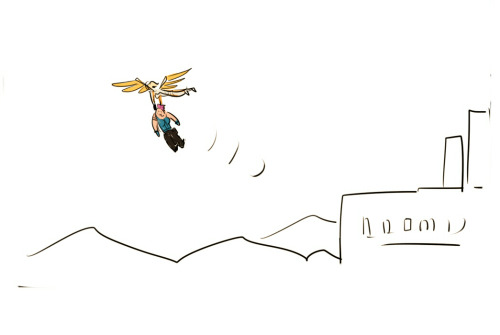The Large Magellanic Cloud Photographed By Eddie Trimarchi

The Large Magellanic Cloud Photographed by Eddie Trimarchi
js
More Posts from Spacecheesus-blog and Others
I love seeing other worlds through the eyes of artists!

Artist Rendition of Saturns moon Titan
js
Neat!

Traveling to Mars (safely AND quickly) with plasma rockets
There has been quite a bit of hype about getting people to Mars. But traveling 35 million miles to the red planet will require a new breed of rockets that are much more powerful and efficient than traditional chemical-fueled rockets.
It takes *A LOT* of fuel to get into space. The Saturn V, which launched spacecraft to the moon, required fuel tanks that were taller than the Statue of Liberty. Traveling to Mars, which is 200 times farther than the moon, means that we would need to build an even bigger rocket that can carry 200 times more fuel — a highly impractical quest.

So NASA researchers are working on a new kind of rocket with electric thrusters that can travel at high speed using less fuel. These plasma rockets can get spacecraft to the moon with one-tenth the tank of fuel used by Saturn V, and are capable of cutting a risky trip to Mars down from two years to less than two months.
Even though plasma rockets are ideal for long-term spaceflight, they do have some shortcomings.
To create plasma, a gas-like matter that’s as hot as the sun, radio waves are used to heat a gas propellant. The problem is that during the heating process, charged ion particles are expelled, causing damage to the thruster’s walls that could potentially lead to a catastrophe.
So what if there was a way that the wall could repair itself?
Gary Li, a UCLA aerospace engineering grad student, is figuring out a way to do just that. In the video below, he explains how his research could help humans travel safely and quickly to Mars:
Space Oddity - David Bowie (1969)
Though I’m past one hundred thousand miles I’m feeling very still And I think my spaceship knows which way to go Tell my wife I love her very much she knows
Thank you, David. Rest in peace.

The Tale of Earth and it’s sister Theia.
Have you found it weird that the earth’s axis is tilted by 23.5 degrees and wondered what led to this? Wait, Where did the moon come from?
Well, Here’s what scientists have theorized.
The Giant Impact Hypothesis
Theia, a mars sized planet collided ( it glanced and thankfully did not collide head on, else it would have destroyed earth ) with the Earth around 4.553 billion years ago.

Theia’s debris gathered together around Earth to form what we now call- The Moon.

The collision between the early earth and Theia was so immense that it tilted the axis of rotation of the early earth by 23.5 degrees.
And it remains tilted so that way even today!!

Why do they believe in this hypothesis ?
Scientists have a very good reason to believe in the Giant Impact Hypothesis:
Earth’s spin and the Moon’s orbit have similar orientations.
Moon samples indicate that the Moon once had a molten surface.
The Moon has a relatively small iron core.
The Moon has a lower density than Earth.
Evidence exists of similar collisions in other star systems (that result in debris disks).
Giant collisions are consistent with the leading theories of the formation of the solar system.
The stable-isotope ratios of lunar and terrestrial rock are identical, implying a common origin

Have a good day !
PC: sarice,
SpaceX Update:
The Jason-3 launch was successful.
The landing attempt on the droneship, however, didn’t go perfectly. The rocket booster is “on target at droneship” but SpaceX has said that a landing leg was broken due to a hard landing. I don’t know exactly what this means for the booster quite yet. I’ll update when I find out.
We’re With You When You Fly

Did you know that “We’re With You When You Fly”? Thanks to our advancements in aeronautics, today’s aviation industry is better equipped than ever to safely and efficiently transport millions of passengers and billions of dollars worth of freight to their destinations. In fact, every U.S. Aircraft flying today and every U.S. air traffic control tower uses NASA-developed technology in some way. Here are some of our objectives in aeronautics:
Making Flight Greener

From reducing fuel emissions to making more efficient flight routes, we’re working to make flight greener. We are dedicated to improving the design of airplanes so they are more Earth friendly by using less fuel, generating less pollution and reducing noise levels far below where they are today.
Getting you safely home faster

We work with the Federal Aviation Administration to provide air traffic controllers with new tools for safely managing the expected growth in air traffic across the nation. For example, testing continues on a tool that controllers and pilots can use to find a more efficient way around bad weather, saving thousands of pounds of fuel and an average of 27 minutes flying time per tested flight. These and other NASA-developed tools help get you home faster and support a safe, efficient airspace.
Seeing Aviation’s Future

Here at NASA, we’re committed to transforming aviation through cutting edge research and development. From potential airplanes that could be the first to fly on Mars, to testing a concept of a battery-powered plane, we’re always thinking of what the future of aviation will look like.
Make sure to follow us on Tumblr for your regular dose of space: http://nasa.tumblr.com
straight ppl: haha they can't be gay they're space rocks lol
me: by that logic they can't be straight either
straight ppl: ...
straight ppl: I don't appreciate your tone.
I need some space cakes in my life.








Galaxy based food
It’s a Spooky Universe

Consider yourself warned!
- Our universe is almost certainly going to die a heat death in which energy in the universe shall be spread so thinly that everything will freeze, the stars will burn out and not shall be left but eternal darkness.

- We might live in a multiverse. If in fact, we do: basic statistics shows that we may in fact be more likely than not be a computer program, living in a sort of simulated universe. Yes, there’s actual scientific research being done to figure out if we’re a hologram and others trying to make progress into multiverse theory.
Imagine the existential horror if we turned out to be the artificial intelligence of someone else’s universe!

- There are almost certainly a multitude of “rogue black holes”, secretly drifting through the Milky Way. If one were to drift into the solar system it could spell our end… that’s obvious though I’m sure.

- As many of you are aware, Earth’s been sending out signals for around a century now. The fact that these signals get exponentially weaker doesn’t mean they stop existing:
Who’s to say such signals can’t be detected by some advanced-and-none-too-benevolent extraterrestrial civilization?
After all, we astronomers regularly tout our exponential advancements in the search for extraterrestrial life. Maybe next time you see that light moving against a backdrop of stars it… never mind. It couldn’t possibly be…

- Certain galaxies, like M87, emit jets of matter at near the speed of light. The high amounts of energy speeding out of these galaxies could, in some cases, end life in any solar system it were to point at:

I hope all the stars above you still seem pleasant!
I’m not necessarily advocating in favor of any of these events and don’t necessarily think any of them are likely but for each item above, there are astrophysicists who do…
(Image credit: Spooky Space Kook of Scooby Doo from © Hanna-Barbera, NASA/ESA, agsandrew/Shutterstock.com, NASA, NASA/ESA/Anderson/van der Marel and NASA and STScI/AURA respectively)


Overwatch & TF2 thign
-
 dragongoblet liked this · 2 years ago
dragongoblet liked this · 2 years ago -
 hisgirlfriday439 liked this · 6 years ago
hisgirlfriday439 liked this · 6 years ago -
 cinturon-cadena liked this · 6 years ago
cinturon-cadena liked this · 6 years ago -
 giorgioooo-blog1 liked this · 6 years ago
giorgioooo-blog1 liked this · 6 years ago -
 i-s-d-m-8 liked this · 6 years ago
i-s-d-m-8 liked this · 6 years ago -
 liquid-geodes liked this · 6 years ago
liquid-geodes liked this · 6 years ago -
 caesarino-zeppeli liked this · 6 years ago
caesarino-zeppeli liked this · 6 years ago -
 16fahri liked this · 6 years ago
16fahri liked this · 6 years ago -
 fagdykefrank liked this · 6 years ago
fagdykefrank liked this · 6 years ago -
 elsdlkfjskljflsjflsd liked this · 6 years ago
elsdlkfjskljflsjflsd liked this · 6 years ago -
 agogirl1 liked this · 6 years ago
agogirl1 liked this · 6 years ago -
 daemondamian liked this · 6 years ago
daemondamian liked this · 6 years ago -
 cyraniadebergerac liked this · 6 years ago
cyraniadebergerac liked this · 6 years ago -
 sweetserenity99 liked this · 6 years ago
sweetserenity99 liked this · 6 years ago -
 ashen-dalia reblogged this · 8 years ago
ashen-dalia reblogged this · 8 years ago -
 inlovelondon liked this · 8 years ago
inlovelondon liked this · 8 years ago -
 lilybug-blog liked this · 8 years ago
lilybug-blog liked this · 8 years ago -
 itbelikewhom reblogged this · 8 years ago
itbelikewhom reblogged this · 8 years ago -
 kurtbrussels liked this · 8 years ago
kurtbrussels liked this · 8 years ago -
 punned2death reblogged this · 8 years ago
punned2death reblogged this · 8 years ago -
 orionredstarr liked this · 8 years ago
orionredstarr liked this · 8 years ago -
 queenofdisneyworld liked this · 8 years ago
queenofdisneyworld liked this · 8 years ago -
 badprincessss-blog liked this · 8 years ago
badprincessss-blog liked this · 8 years ago -
 luqaroon liked this · 8 years ago
luqaroon liked this · 8 years ago -
 a-nobella liked this · 8 years ago
a-nobella liked this · 8 years ago -
 littlepoeticnegus liked this · 8 years ago
littlepoeticnegus liked this · 8 years ago -
 dabeatnik liked this · 8 years ago
dabeatnik liked this · 8 years ago -
 btwngalaxies reblogged this · 8 years ago
btwngalaxies reblogged this · 8 years ago -
 sourstrawbs14 liked this · 8 years ago
sourstrawbs14 liked this · 8 years ago -
 theblkguru reblogged this · 8 years ago
theblkguru reblogged this · 8 years ago -
 flitchino liked this · 8 years ago
flitchino liked this · 8 years ago -
 myniggapaco reblogged this · 8 years ago
myniggapaco reblogged this · 8 years ago -
 poly-mathic liked this · 8 years ago
poly-mathic liked this · 8 years ago
Hello, folks! I mainly like to post things of the space, cartoons, and caffiene variety. Enjoy your stay! :)
37 posts